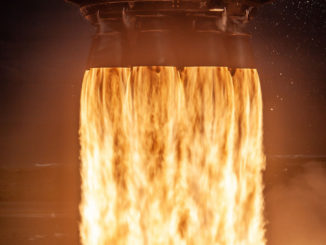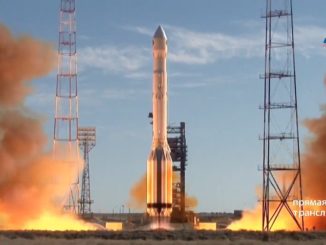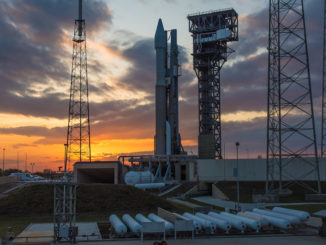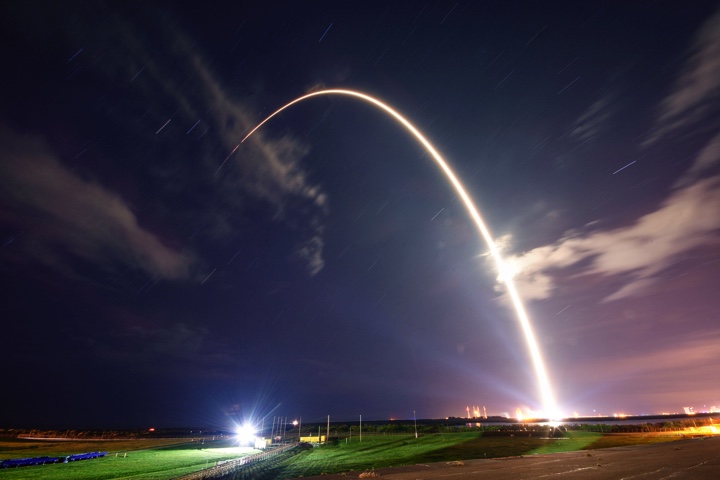
For the second time in seven weeks, SpaceX, Telesat and SSL teamed up for a commercial satellite launch from Cape Canaveral early Monday, this time successfully deploying into orbit a high-power telecom payload developed in a joint venture with a Hong Kong-based company.
The Telstar 18 VANTAGE communications satellite, also known as APSTAR 5C, was released into orbit by the Falcon 9’s second stage around 32 minutes after liftoff, which occurred at 12:45 a.m. EDT (0445 GMT) Monday.
The Falcon 9’s thundering departure from Cape Canaveral occurred more than an hour later than planned, a delay to allow pop-up thunderstorms to clear the spaceport.
Once the storms moved offshore, the Falcon 9 launch team gave a “go” to kick off an automated computer-run countdown sequencer, and super-chilled RP-1 kerosene and cryogenic liquid oxygen began flowing into the rocket at T-minus 35 minutes.
After running through a pre-flight steering check, the Falcon 9 switched to internal power and pressurized its propellant tanks before firing its nine Merlin main engines three seconds before liftoff.
Hold-down clamps opened to release the rocket moments later, and the 229-foot-tall (70-meter) soared into the sky, heading east over the Atlantic Ocean to steer its payload toward an eventual perch over the equator.
The slender rocket fired through scattered clouds with 1.7 million pounds of ground-shaking thrust, arcing downrange before releasing its first stage to come back to Earth.
As the Falcon 9’s booster stage aimed for a SpaceX recovery barge in the Atlantic, the upper stage lit its single engine to propel the mission’s commercial satellite payload — valued at more than $200 million — into orbit.
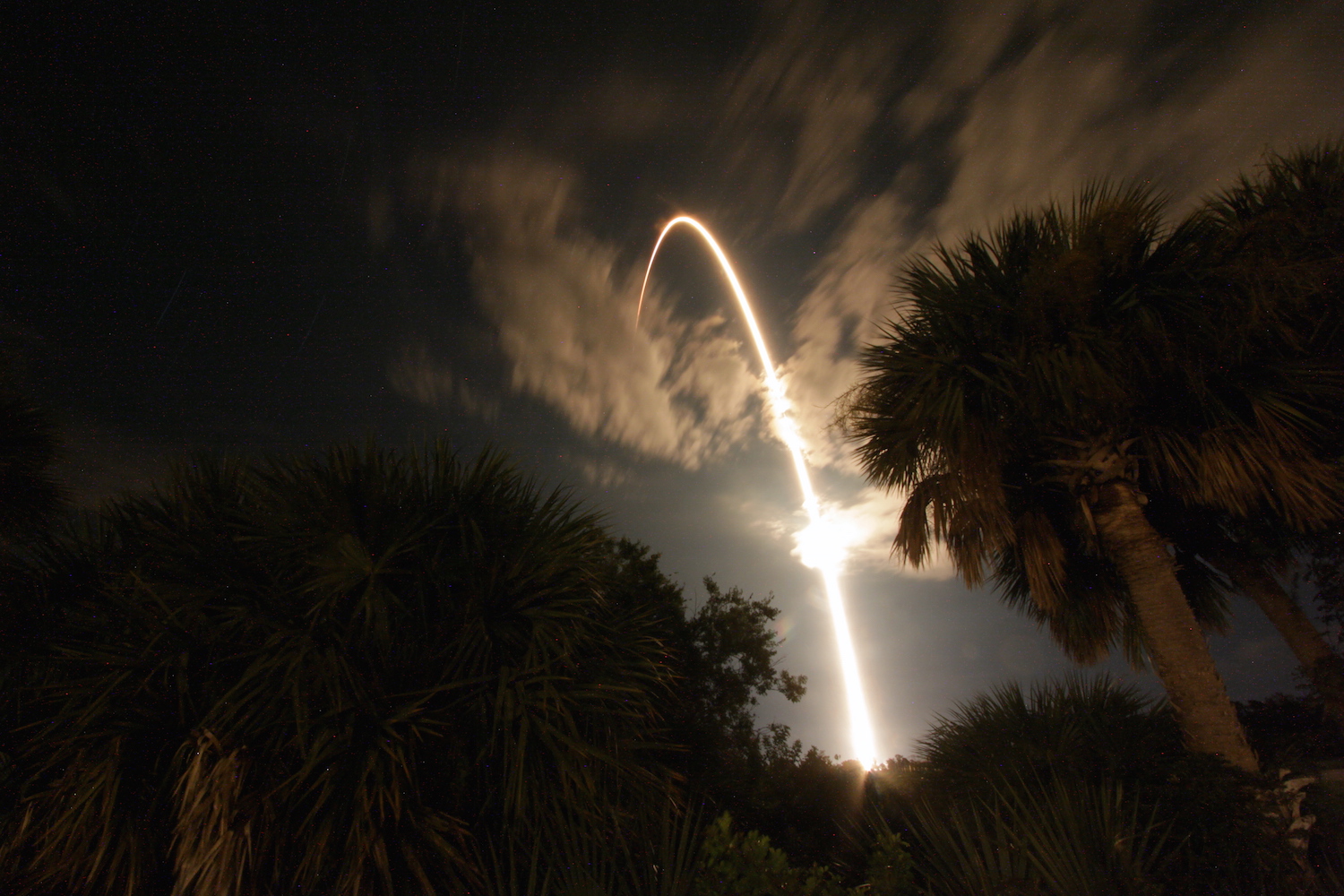
The upper stage engine shut down a little more than eight minutes after liftoff after placing the Telstar 18 VANTAGE/APSTAR 5C communications satellite in a preliminary parking orbit. Moments later, the Falcon 9’s first stage fell out of darkness — with an engine blazing — and set down on SpaceX’s drone ship “Of Course I Still Love You” parked roughly 400 miles (650 kilometers) east of Cape Canaveral.
The first stage from Monday’s mission will be inspected, and likely reused on a future SpaceX launch. The landing was the 29th time SpaceX has recovered one of its Falcon boosters intact since the company first accomplished the feat in December 2015.
But the Falcon 9’s job was not complete, and the upper stage engine reignited for a critical second burn to raise the height of its orbit closer to the satellite’s eventual operating post.
The second upper stage firing resulted in an on-target orbit, SpaceX said, and live video downlinked through a ground station showed the Telstar 18 VANTAGE/APSTAR 5C spacecraft flying away from the rocket 32 minutes into the flight in sunlight over Africa.
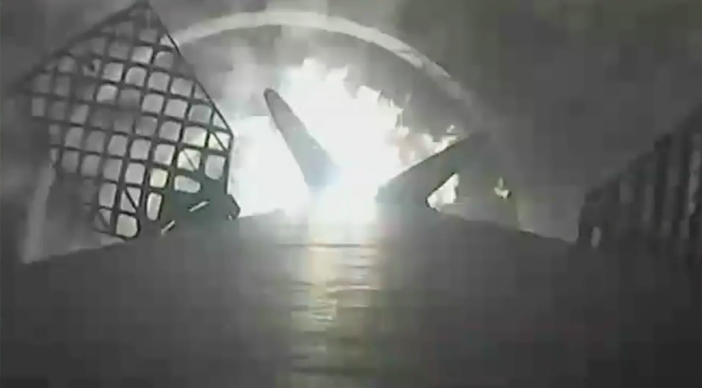
A spokesperson with Telesat, the Ottawa, Ontario-based owner and operator of the spacecraft, said ground controllers received the first signals from the new satellite shortly after deployment from the Falcon 9, confirming it survived the launch.
Tracking data published by the U.S. military showed the satellite was placed in an orbit ranging between 161 miles (260 kilometers) and 11,225 miles (18,066 kilometers), with an inclination of 27 degrees to the equator.
The heavyweight spacecraft weighed more than 15,560 pounds (about 7,060 kilograms) at launch. Much of that weight comes a hefty load of liquid propellant to be consumed placing the satellite in its operational orbit.
Next up for the satellite, built by SSL in Palo Alto, California, is a sequence of orbit-raising maneuvers using a combination of its liquid-fueled rocket engine and electric thrusters.
The satellite will circularize its orbit more than 22,000 miles (nearly 36,000 kilometers) over the equator, extend its power-generating solar panels, and unfurl a set of antennas before commencing a test campaign. Once the testing is completed, Telstar 18 VANTAGE/APSTAR 5C is expected to enter commercial service next month.
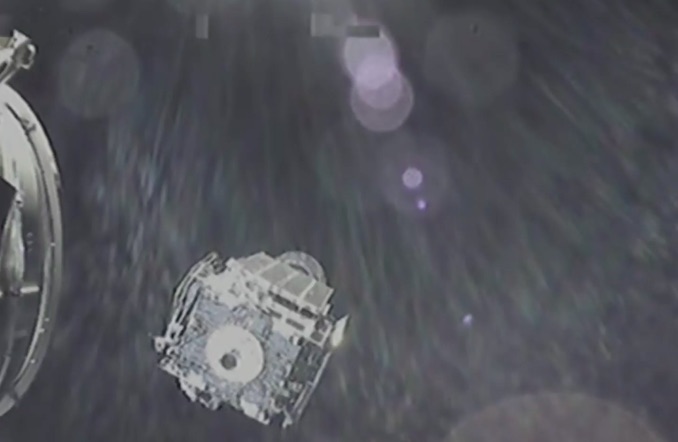
The satellite will park itself in geostationary orbit at 138 degrees east longitude, where it will match Earth’s rotation and replace the aging Telstar 18/APSTAR 5 spacecraft launched in 2004.
“We have an embedded base that’s on Telstar 18 today that will migrate over to Telstar 18 VANTAGE,” said Tom Eaton, Telesat’s vice president of international sales, in a pre-launch interview. “So there’s an element of continuity of service at play here by replacing the existing satellite, but Telstar 18 VANTAGE, since it’s the third of our high-throughput satellites, carries a lot more flexibility, switchability in its coverages, and then has high-throughput capability as well.”
Carrying a combination of broad regional beams and high-bandwidth spot beams, the satellite’s coverage area will span from India and Pakistan in the west, to Hawaii in the east.
APT Satellite — also known as APSTAR — of Hong Kong will use 57.5 percent of the satellite’s communications capacity, in exchange for funding 57.5 percent of the mission’s total cost.
“Through (the) APSTAR 5C Satellite, we will be able to maintain reliable services to our existing customers of APSTAR 5 satellite, and to assure the continuity of their businesses,” said Cheng Guangren, executive officer and president of APT Satellite, in a statement at the time of the satellite’s procurement in 2015. “Meanwhile, (the) APSTAR 5C satellite will carry more transponders, expand to broader service areas, and include regional high-throughput (HTS) capacities to satisfy growing market demand in Asia-Pacific region.”
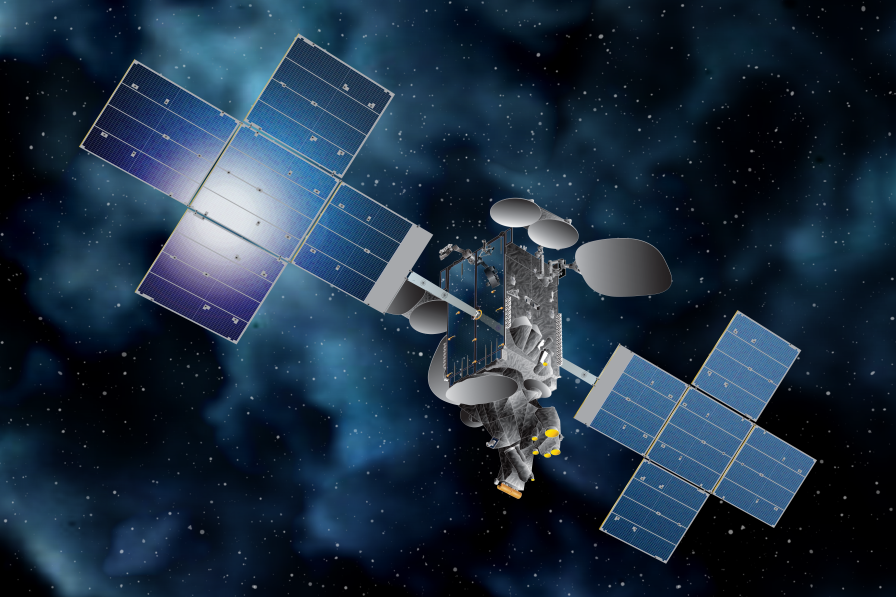
The Telstar 18 VANTAGE/APSTAR 5C spacecraft hosts two payloads — one in C-band and another in Ku-band — to provide services that range from direct-to-home television broadcasting, to Internet connectivity, to cellular phone bandwidth.
“With this newly-designed satellite, markets that we’re looking at … would be the mobility market in Asia, which is rapidly growing,” Eaton said. “Maritime is what we typically think of, but also aero, so connectivity to aircraft.”
In-flight WiFi for airline passengers traveling across Asia and neighboring oceans, plus Internet services for tourists on cruise ships, will be prime markets within Telesat’s reach with the new satellite.
“Those are markets that, with this satellite, we’ll be able to provide solutions for our customers, where we otherwise couldn’t with Telstar 18,” Eaton said.
“The Asia-Pacific region is one that’s in need of connectivity for remote communities, especially when you look at a country like Indonesia, where they have a government initiative to connect all of the country, and satellite is the best way to do that,” Eaton said. “Another area in the telecom space is backhaul for cellular and mobility towers, and there’s a fair amount of oil and gas and mineral exploration that satellite supports, so we’re interested in that market, as well as there are some DTH (direct-to-home television broadcast) opportunities,” Eaton said.
Monday’s launch was delayed from last month to allow SpaceX to complete work to ensure the rocket was ready for liftoff.
The mission was a reunion between SpaceX, Telesat and SSL after the successful launch of the Telstar 19 VANTAGE communications satellite July 22, which also used a Falcon 9 rocket with an SSL-built spacecraft.
Telesat announced the Telstar 19 VANTAGE satellite, which provides telecom services over the Americas, became operational in late August.
“The timing just worked out that these were going to be close, so we’ve been anticipating that,” Eaton said before Monday’s launch. “In terms the mood and the attitude at Telesat, it’s just what we do. Everybody has been on pins and needles to get Telstar 18 VANTAGE launched. Telstar 19 VANTAGE was just a stellar performance by SpaceX, and I would say by Maxar (SSL) as well because everything is working well.”
Going into Monday’s launch, APSTAR operated five geostationary communications satellites, while Telesat counted 16 geostationary telecom craft in its fleet, in addition to a pathfinder satellite for a planned broadband network in low Earth orbit.
Monday’s mission was the 16th SpaceX launch of the year, and the 34th consecutive successful flight by SpaceX’s Falcon rocket family since an on-pad explosion in 2016.
The launch company’s next flight is scheduled for Oct. 7, when a Falcon 9 rocket is scheduled to take off from Vandenberg Air Force Base in California with Argentina’s SAOCOM 1A Earth observation satellite. That mission is expected to feature the first return of a Falcon 9 booster to land in California.
Email the author.
Follow Stephen Clark on Twitter: @StephenClark1.

